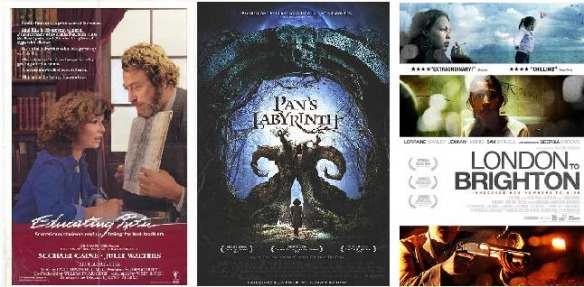What is Transnationality?

TRANSNATIONAL “Adjective – extending or operating across national boundaries. Noun – a multinational office” (Oxford Dictionaries, 2009)
Transnationality is closely linked with globalisation, within the notion that a product in this case a film text can use and display elements from different nations across the globe, making the film a transnational text.
Previously to transnationality, there were national filmic texts. Although difficult to identify, national films were purely created and funded by one nation. Recent years a defining a national text has been difficult to identify, as it must be a text which only managed a release within the particular nation it was released. Within the past 20 years many audiences seek something slightly different to a generic Hollywood creation and have ventured into art house cinemas as well as following world cinema. These movements within the past decades have been closely linked to the internet and the sheer ease of accessing knowledge of film and becoming aware of them. Although Hollywood is still the leading runner in producing the grandest productions and generally most popular, the other film industries are giving Hollywood stiff competition, an early example of this is Educating Rita (Gilbert, 1983).
Educating Rita is possibly one of the most successful British film texts and originally was a national film, being funded and released within the UK. Adapted from the stage version written by British playwright Willy Russell and directed by one of the United Kingdom’s leading directors Lewis Gilbert, Educating Rita had an all British cast and crew and launched the career of Julie Walters. Educating Rita went onto huge success nationally within the UK, and due to this popularity, received international recognition within America and subsequently was nominated for two Academy awards.
Transnationality is closely linked with globalisation, within the notion that a product in this case a film text can use and display elements from different nations across the globe, making the film a transnational text.
Previously to transnationality, there were national filmic texts. Although difficult to identify, national films were purely created and funded by one nation. Recent years a defining a national text has been difficult to identify, as it must be a text which only managed a release within the particular nation it was released. Within the past 20 years many audiences seek something slightly different to a generic Hollywood creation and have ventured into art house cinemas as well as following world cinema. These movements within the past decades have been closely linked to the internet and the sheer ease of accessing knowledge of film and becoming aware of them. Although Hollywood is still the leading runner in producing the grandest productions and generally most popular, the other film industries are giving Hollywood stiff competition, an early example of this is Educating Rita (Gilbert, 1983).
Educating Rita is possibly one of the most successful British film texts and originally was a national film, being funded and released within the UK. Adapted from the stage version written by British playwright Willy Russell and directed by one of the United Kingdom’s leading directors Lewis Gilbert, Educating Rita had an all British cast and crew and launched the career of Julie Walters. Educating Rita went onto huge success nationally within the UK, and due to this popularity, received international recognition within America and subsequently was nominated for two Academy awards.
A more contemporary national British text is London to Brighton (Williams, 2006). London to Brighton features an unknown cast and director and was made on the minimal budget of £80'000, by today’s standards is considerably low, the film received critical acclaim and received award nominations in the UK, but failed to gain international recognition hence its reasoning for its classification as a national piece of cinema.
With the addition of globalisation it remains difficult to identify a national piece of cinema as the film industry has outlets and departments from every major studio across the globe, contributing to globalisation and transnationality. Thus is subsequently a “response to an increasing awareness of the limitations of conceptualising film in terms of national cinemas, and an acknowledgement of the changing nature of film production and distribution as a part of wider patterns of globalisation.” (Shaw, 2009). Transnationality is also a vital element within contemporary film as audiences are striving to see something diverse to the predictable Hollywood Blockbuster. Foreign transnational films such as Pan’s Labyrinth (Del Toro, 2006) have competed with Hollywood, and received international acclaim due to its phenomenal success. Pan’s Labyrinth is complied contribution from many nations such as a Mexican director, Spanish funding and cast and is classified as transnational. Transnationality has almost become integral part of the film making process, allowing talented filmmakers such as Del Toro to gain the recognition they deserve, as without transnationality spectacles like Pan’s Labyrinth wouldn’t be possible, as the following quote proves “Transnational exchanges have long been central to film making in terms of funding and the cast and crew, and an increasing numbers of films in the international market cannot be identified with a single nation, with many films shooting in a number of countries, relying on a multi-national cast and crew, and funded by a range of production companies” (Shaw, 2009).
Pan's Labyrinth's success is also a result of heavy exposure on sites such as 'YouTube' with trailers and clips of the film, and also the addition of the powerful word of the mouth, the film received the respect it deserves within the competitive American dominating market.
For other transnational films click link EXAMPLES to view them. There are bulleted points defining why the texts are classified as transnational. So to what extent has online film and video created this culture of transnationality? This site aims to answer this questions to continue, click this link to ONLINE FILM to discover more.
With the addition of globalisation it remains difficult to identify a national piece of cinema as the film industry has outlets and departments from every major studio across the globe, contributing to globalisation and transnationality. Thus is subsequently a “response to an increasing awareness of the limitations of conceptualising film in terms of national cinemas, and an acknowledgement of the changing nature of film production and distribution as a part of wider patterns of globalisation.” (Shaw, 2009). Transnationality is also a vital element within contemporary film as audiences are striving to see something diverse to the predictable Hollywood Blockbuster. Foreign transnational films such as Pan’s Labyrinth (Del Toro, 2006) have competed with Hollywood, and received international acclaim due to its phenomenal success. Pan’s Labyrinth is complied contribution from many nations such as a Mexican director, Spanish funding and cast and is classified as transnational. Transnationality has almost become integral part of the film making process, allowing talented filmmakers such as Del Toro to gain the recognition they deserve, as without transnationality spectacles like Pan’s Labyrinth wouldn’t be possible, as the following quote proves “Transnational exchanges have long been central to film making in terms of funding and the cast and crew, and an increasing numbers of films in the international market cannot be identified with a single nation, with many films shooting in a number of countries, relying on a multi-national cast and crew, and funded by a range of production companies” (Shaw, 2009).
Pan's Labyrinth's success is also a result of heavy exposure on sites such as 'YouTube' with trailers and clips of the film, and also the addition of the powerful word of the mouth, the film received the respect it deserves within the competitive American dominating market.
For other transnational films click link EXAMPLES to view them. There are bulleted points defining why the texts are classified as transnational. So to what extent has online film and video created this culture of transnationality? This site aims to answer this questions to continue, click this link to ONLINE FILM to discover more.
Below is the mentioned film's posters and the Spainish trailer for the transnational Pan's Labyrinth, it displays its transnational element by having Spainish dialogue and English written titles. Also Featured is the trailer to national film London to Brighton, displaying its extreme elements of traditional British realism and slang.

